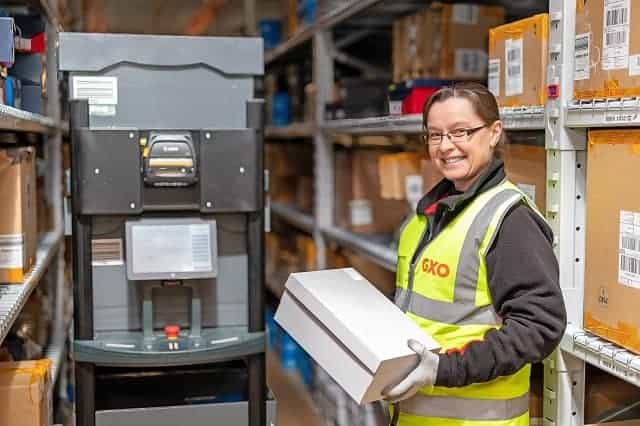Zone picking is a method of order picking in warehouse management and supply chain logistics. One of several picking methods, it involves the division of stock-keeping units (SKUs) into a set of different zones where warehouse employees’ teams are assigned to pick and sort from inside each designated zone. In this article, we’ll take a look at how it works, its benefits, how it can be combined with other picking methods, and best practices for efficient picking processes.
How zone picking works

Each picker group is assigned to a zone. They’re responsible for picking all SKUs located within that zone for each order. Sometimes this operation involves moving different SKUs from one zone into another, which is known as “pick and pass.” With this method, there’s one scheduling period per shift.
In some warehouse environments, zones will be sectioned off according to either human or robot-assisted picking. For example, in an electrical component retail warehouse there may be a need to use a powered pallet truck (PPT) for large and bulky items, whereas an unassisted human picker may pick lighter items in another zone. These two item picks may need to be collated and will eventually find each other by transferring to the same zone or to the sorting and packaging area.
In warehouses with robot-assisted picking, dynamic zones can be set and managed without pickers even being aware of it. 6 River Systems’ intelligent work allocation software evaluates the order pool and identifies opportunities to group tasks together within aisles or dynamic zones to minimize walking. 6 River Systems’ artificial intelligence creates dynamic zones for associates, with zones shrinking and expanding in real-time based on the profile of work that needs to be completed. Implementing pick and pass across dynamic zones ensures that warehouse associates and Chucks, 6 River Systems’ collaborative mobile robots, are fully utilized throughout the day.
Benefits of zone picking
As a basic fulfillment process, zone picking in a warehouse has a major impact on supply chain productivity. The picking perimeter is segmented into separate pick zones, and pickers assigned to each zone will only pick items within it. It allows zones to be set up based on distinct criteria, such as fast-moving and slow-moving SKUs or a zone dedicated to high-security SKUs. Another benefit is that each zone can have its own storage strategy, order picking equipment and technology.
Essentially, it operates like a standard assembly line. Cartons or other containers move along a conveyor line or belt or are transported from zone to zone by a manual cart or collaborative mobile robot, where SKUs are then added from each zone. Once the order is fulfilled, picking is complete, and the items are transported to packaging and shipping areas.
This picking method is best suited for large warehouses that deal with a large number of SKUs that have unique characteristics or picking requirements. It vastly reduces travel time as inventory pickers remain in their assigned zones rather than traveling throughout the warehouse, and cartons filled with items needed for each order come to them. By working in a smaller zone, pickers become more familiar with the SKUs in their zone and their pick locations, resulting in faster, more accurate picking.
It is also flexible. It can be combined with other picking methods for a hybrid approach that best suits your business’s needs. Some of these hybrid picking methods include:
- Zone-wave picking
- Zone-batch picking
- Zone-batch-wave picking
In the zone-wave picking method, pickers pick all SKUs that are stocked in their zone for all orders simultaneously, with a single scheduling window per shift. Zone-batch picking has a scheduling window, as well. In this hybrid picking method, pickers pick all SKUs for a group of orders (or batch of orders) at the same time within their zone, one SKU at a time.
Zone-batch-wave picking is the most complex method of the three hybrid methods. In this picking method, pickers pick multiple SKUs at the same time, with multiple scheduling windows for each shift.
Disadvantages
Working with a single scheduling period per shift allows warehouse managers to plan ahead, but it also means there’s a cutoff point for orders to be queued for picking. Orders received after the cutoff point will be processed during the next shift.
Additionally, load balancing zones for proper labor management can be challenging. If orders queued for picking during a particular shift consist of SKUs from just one or two zones, warehouse associates in other zones can take advantage of downtime to replenish forward pick locations.
Best practices

Once the fundamentals have been established, by creating designated groups and zones and setting up workstations, these best practices will take it to the next level.
Organized workstations are an often-overlooked aspect of warehouse management. Leading logistics professionals recommend using the simple “5S” method. That is: sort, set in order, shine, standardize and sustain. These techniques help maintain workstation cleanliness while also limiting clutter. Organized workstations help keep associates focused on the tasks at hand, reduce errors and improve overall safety.
Optimize labor efficiency by managing your warehouse layout and storage. High volume items should be placed somewhere near the front of the warehouse to eliminate any unnecessary travel time. Items that are frequently sold together should also be stored in proximity to one another’s zones for the benefit of your pickers.
Analyzing and streamlining your picking processes correctly will jumpstart warehouse efficiency.
Download our white paper, 7 Reasons Why Warehouse Robots Beat Traditional Automation, to learn more about how warehouse robots can benefit your piece picking operations.
For more on zone picking, check out our post on Zone Picking vs Wave Picking: Which is Best?


